
The 1964 full-size Chevrolets marked the end of the GM B-body chassis and X-frame that dated to 1958. Although 1965 would usher in an all-new big Chevy. the 1964 was treated to yet another restyle, this time a little more extensive than in 1963. They were fresh and modern enough in mid-decade 1960s America, but they also looked somewhat plain compared with the prettier (in your author’s opinion) ’62 and ’63 models. As usual, several different models were available, from plain to fancy. Biscayne, Bel Air, Impala and the top-of-the-line Impala SS. Said SS available only as a two-door hardtop and convertible.

In the mid ’60s GM was going gangbusters, especially at Chevrolet Division. 536,329 sedans, 442,292 Sport Coupes, 200,172 Sport Sedans, 192,827 wagons, 120,951 two-door sedans and 81,897 convertibles came off the line that year. And those were all full size standard Chevrolets. No pickups, no crossovers (perish the thought!), no Corvairs, Corvettes or Chevelles. With a 119″ wheelbase and 209.9″ overall length, these cars had plenty of room and as you’d expect, they didn’t lack for stretch-out room and trunk space.
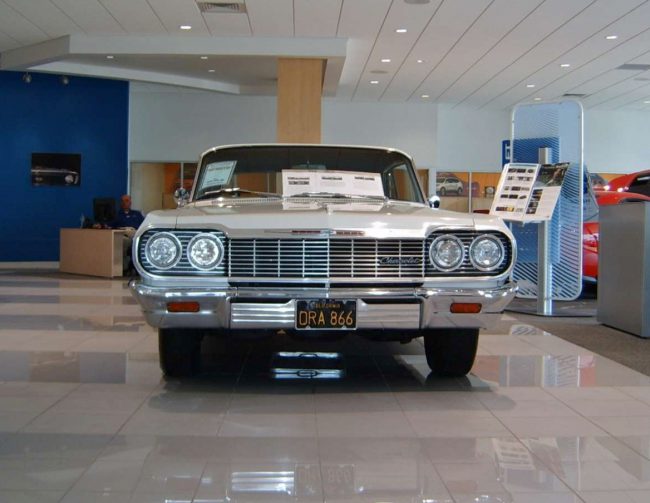
But back to the Super Sport. Inside and out, the SS received special trim that set it apart. Instead of the C-shaped chrome trim that followed the standard Impala’s body side “coves”, the SS got a broader, full-length spear with a gold engine-turned insert.

As had been the case since 1958 (not counting the ’59 Chevrolet’s cat’s-eye taillights), all Impalas received triple taillight units per side while lower-level models, such as the Biscayne and Bel Air, wore twin taillights. Like the large “jet exhaust” taillights on contemporary Fords, it was a clever way to identify a Chevy or a Ford at night, when taillights were all you could see.
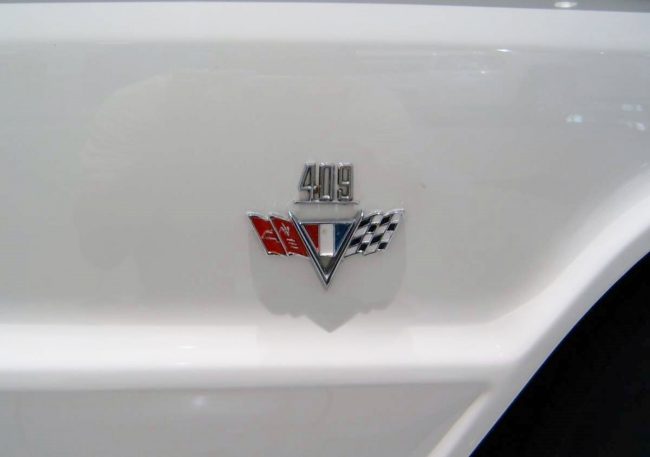
The standard engine for the 1964 SS was, believe it or not, the Turbo-Thrift 230 cu in, 140-hp straight six. As my friend Luke Besse would say, Yep! An SS Sport Coupe cost $2,839 with the six, and could be rightly called the “all hat and no cattle” version. For an extra $109, however, you could get a 195-hp Turbo-Fire 283 with a single two-barrel carburetor and single exhaust. Of course, these were just the “cooking” engines–new car buyers with a need for speed could choose from an extensive menu of available engines. Want a V8? No problem, just pick one!
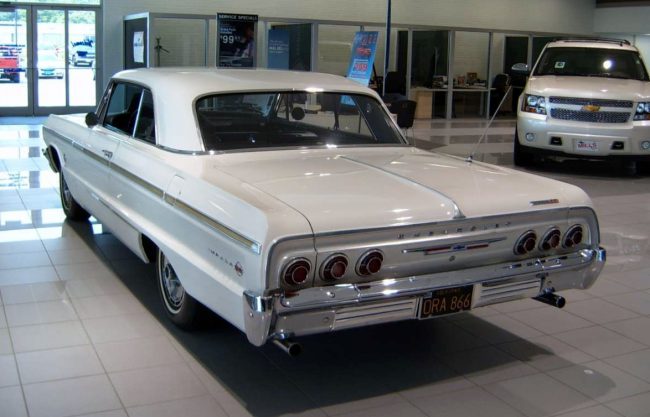
Unlike today, most dealers didn’t stock a wide variety of cars for their lot. Most people wanted their car just so, which meant ordering it out to their exact specifications. Yes, many folks ORDERED their cars back then! I know, hard to believe. In the engine department, one had a choice of slow, decent, fast, faster and fastest.
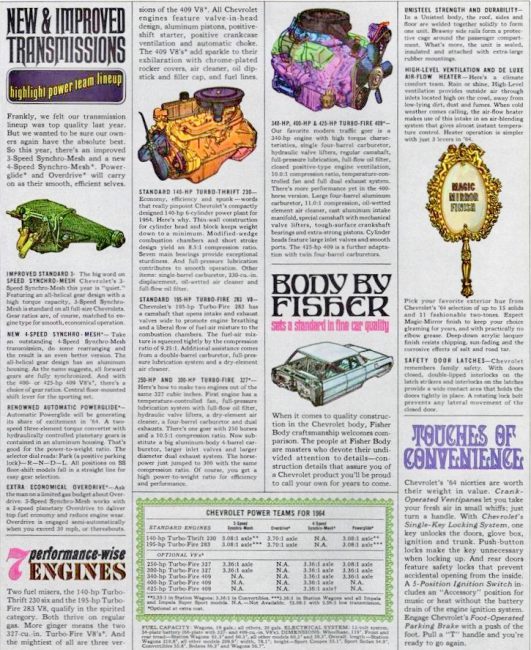
Above the standard 195-horse 283 were 250- and 300-hp versions of the 327 cu in V8. Both came standard with a manual three speed. Yes, the fabled three on the tree. Optional was the Powerglide automatic or a floor-mounted four-speed manual transmission. For most new car shoppers, any of those choices were more than enough engine.
But there was even more power (MORE POWER ARRGH ARRGH ARRGH!) available to those with the desire and the cash. The soon-to-be-legendary 409.
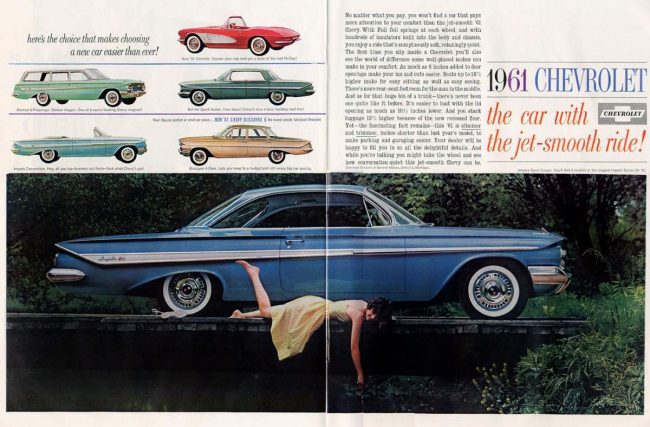
The 409 V8 was introduced along with the new Super Sport model in December of 1960, a few months after the other 1961 models. It was a direct development of the Chevy 348 “W” big block engine first introduced in 1958. Initially available with a single four-barrel carburetor, it produced 360 horsepower, which was bumped to 380 for 1962. A racing version with dual four-barrel carbs, aluminum intake, and forged crankshaft produced 409 horsepower, thus achieving the vaunted “one horsepower per cubic inch” rating.
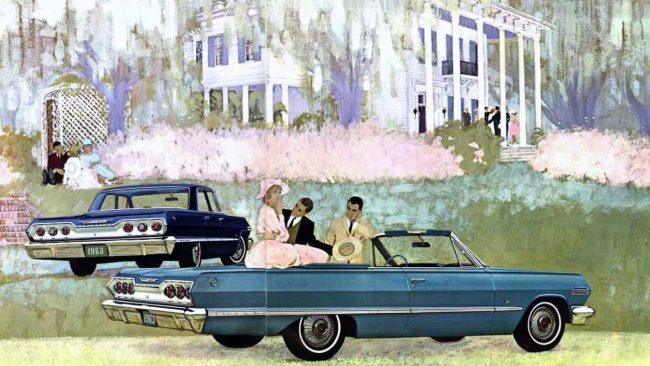
By 1963, the 409 was offered in 340-, 400- and 425-horsepower variants. For hot rodders and Walter Mitty-types with the cash, the brawny, stylish 1963 models had it all, and were perhaps the most beautiful of the 1960s full-size Chevrolets. GM and Bill Mitchell were really at the top of their game.

The same lineup of 409s returned for 1964. The 400- and 425-horsepower versions were available only with a manual transmission, but you could get the 340-horse version with Powerglide.

Despite its power–and even despite the Beach Boys song–the 409’s run had by now pretty much reached its end. As time and GM engineering marched on, it was replaced by the 396 cu in big-block Mark IV V8 mid-year during the 1965 model year. In no time, the 425-horse 396 would gain just as much fame and admiration, if not more, as the 409.
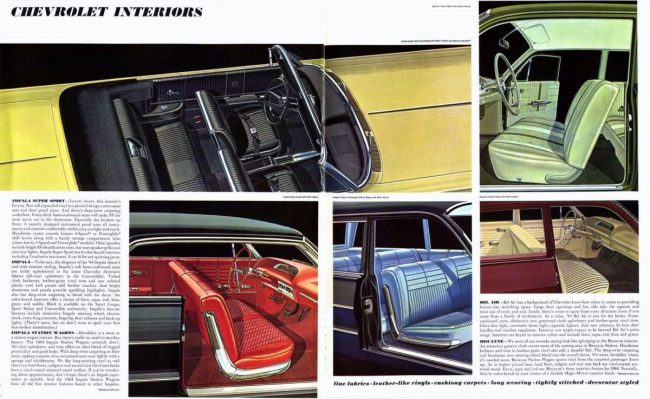
While the “regular” Impala was very nice, and offered most any option and accessory you could ever want, the Impala SS took things a step further. Both hardtop and convertible Super Sports featured unique, leather-grained upholstery, bucket seats and a center console.

Simulated engine-turned dash inlays, rear-seat radio speaker, door reflectors, dual dome and foot well courtesy lamps, and SS badging rounded out the interior upgrades.
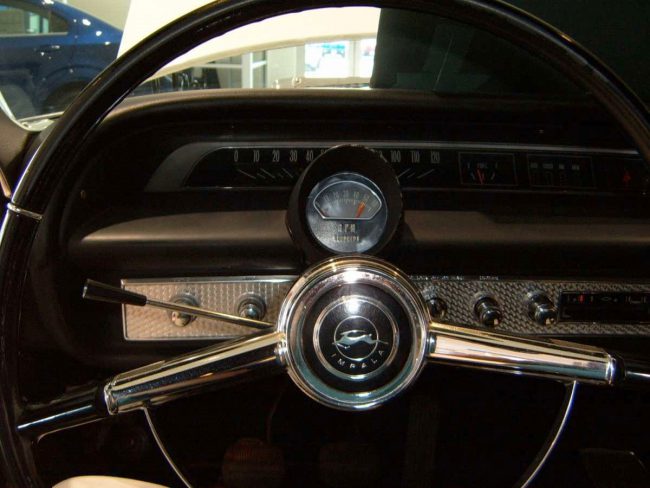
Beyond all these cool features and upgrades, SS models could be dolled up even more, thanks to a variety of available factory options. Among them: Deluxe air conditioning with heater ($364), tinted windows ($38 all around, $22 for just the windshield), two-tone paint ($16), a six-way power seat ($97) and a $48 tachometer, as sported by our featured car. Foreshadowing the Grand Broughamage to come in a year or two, Impala SS hardtops could wear a vinyl roof covering for an extra $75.
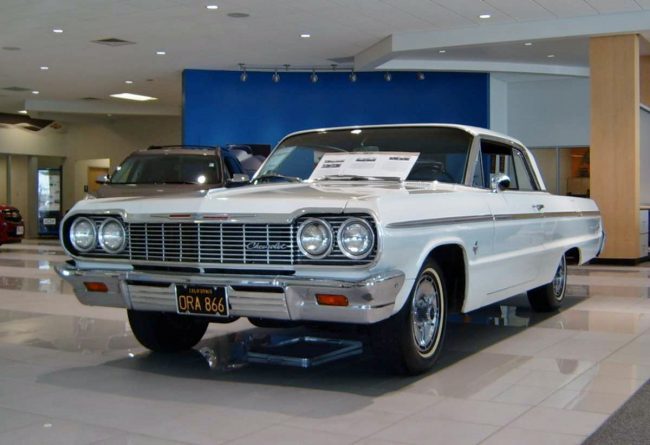
According to the good old Standard Catalog of American Cars, 185,325 ’64 Impala SSs were made, and 8,684 409 V8s were installed in full-size Chevrolets. Somewhere in those numbers is our featured car, which is owned by David Mills of Mills Chevrolet in Davenport, Iowa. I was lucky enough to extensively check out this car when it was on display at the dealership back in July of 2012.
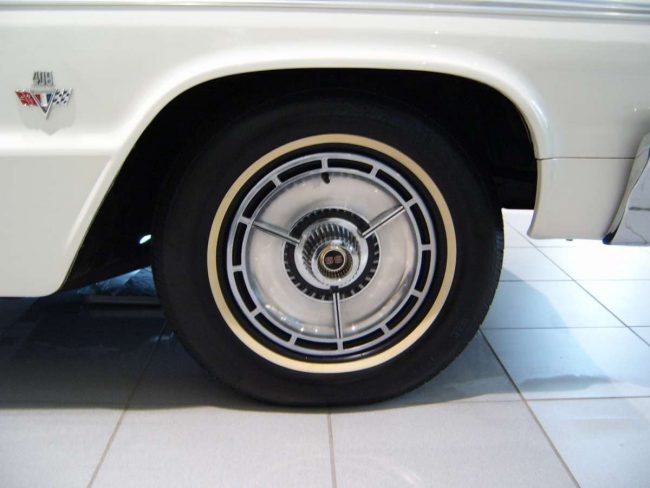
This SS is a largely original car. The numbers-matching 409 V8 was cast on May 21, 1964, at the Tonawanda, NY engine plant. The finished engine was then sent to the Van Nuys, CA plant for installation. This Impala was built during the third week of June, 1964.
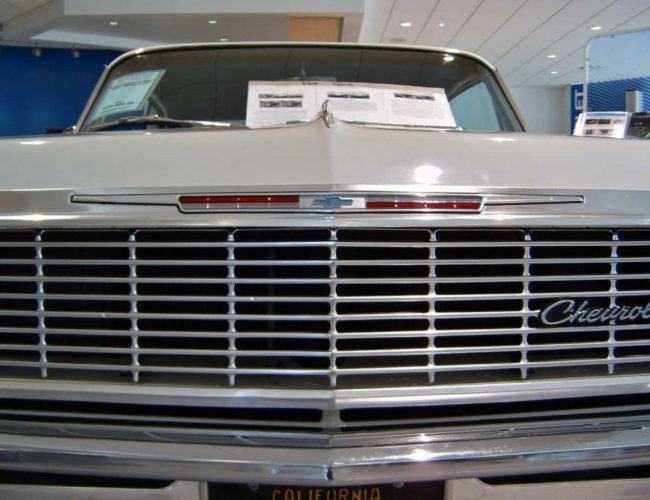
Other than a repaint in the original Ermine White, the car is unrestored, and shows approximately 74,000 miles. It spent much of its life in California, until it was purchased by Mr. Mills. It still has its original “black plate” California license plates, too. This car is a true time capsule.
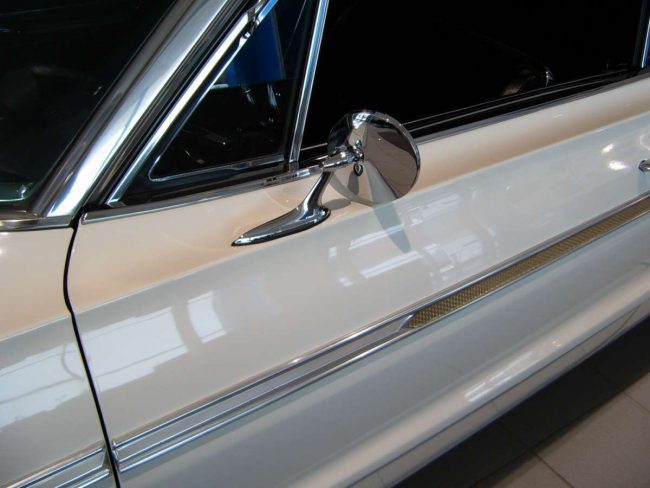
As befitting its top-of-the-line status, this car has plenty of options, including the chrome engine dress-up kit, tachometer, power steering and dual outside rear view mirrors.
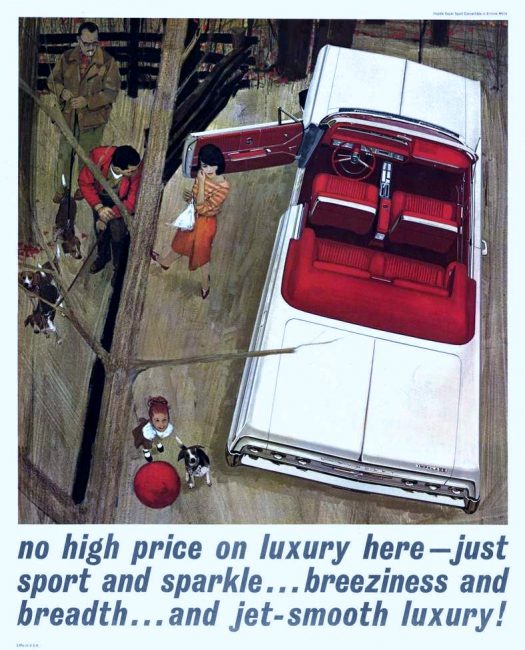
Nineteen sixty-four was a big year for Chevrolet. The refreshed Impala line, mechanically improved Corvair and all-new midsize Chevelle produced a lot of happy folks at the Chevrolet division–1965 would be an even better year, not just for Chevrolet, but for all of Detroit. Echoing the sales performance of a decade earlier, 1965 would set many production records as Bill Mitchell’s squared off, linear styling evolved into more sculpted and sweeping designs. But in 1964, things were going quite well, making all of that–for now–strictly academic.
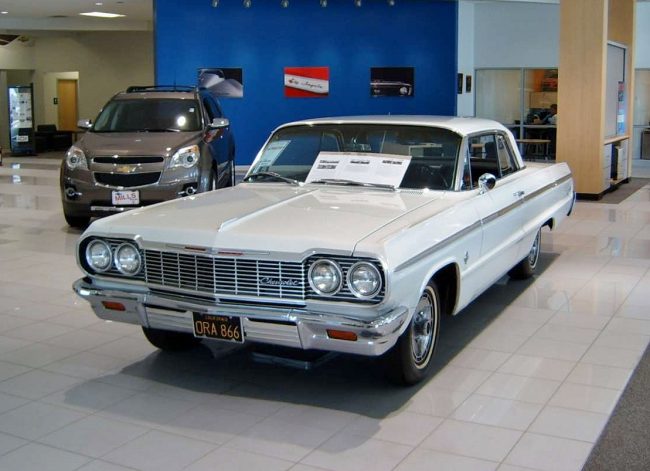
Once again, I’d like to thank Mr. Mills for taking the time to show me his classic Chevrolet and sharing the story behind it. His 409 is a beauty!









22 Comments
As the original owner of a ‘96 Impala SS, I’ve always regarded the ‘64 model as peak-Impala. Especially in white over red interior.
I well remember these when new, sadly the old 409’s I ever knew were i the Dealer, all the local ones were 6’s or 283’s .
Still very good cars for very little money .
They didn’t rust out in three years like so many others did back then .
Just DON’T crash them ! they folded up like wet cardboard .
-Nate
Funny you should say that. My first thought when looking at that dash was how uncomfortable it would be impaled on that steering column.
We spent some time in a dark brown Impala 400, but it was a ’72.
The steering wheel was mildly dished, IIRC. Which was an improvement from the flat steering wheels which were offered through 1954…and, if I remember, even to 1956 in standard trim.
The 1957s, if my memory serves, had a dished steering wheel. This was something that Ford had pioneered, under Lido. Trying to sell safety in the mid-1950s Fords. GM followed, half-heartedly.
Padded wheels didn’t arrive until 1969.
I had a lot of acquaintence with those. Like I indicated, my old man had Company Cars – a 1963, briefly, then a 1964 and a 1966. All Chevrolets. Meantime, a friend’s mother had a rusty 1956…not that old, but man, they rusted. Then in high school, the Tri-Five madness took off…oddly, the pinnacle in those times, for us kids, was the gaudy 1957s. The ’55s were respected; but nobody had a 1956. There was a 1956 Nomad in another neighborhood, occassionally made its way to the city park for Little League play.
But that’s how I came to know all these interiors.
Always loved these–my favorite year of my favorite car of the 60s.
Tom,
Excellent article, as always. Enough history to put the feature into perspective, then a very detailed description of the car and the year. I really like the “one a day” theme that’s working recently!
I am lucky to have him working so hard to bring these articles to his. If this site actually made money I would give him some!
I’m clicking ad’s as fast as I can. 🙂
Do you mean that mining script chewing up my cpu isn’t yours? I have to remind myself to stop visiting ‘questionable’ sites.
So many trend-leaders this car. First, as you said, they were Peak Impala. Or, Peak Chevrolet Full-Size. They were everywhere.
Then, they showed the styling trend that was to continue for another decade: The flat, upright grille profile. Consider the similarity to the 1968 Ford full-size. The headlights on cars had moved down from fender pods five years earlier; and now, instead of chiseled profiles, there was this cubist front.
As with other styling trends, the first move was not permanent. The 1965 reverted to contoured shape, and while muted, the contours would remain until 1971; but the flat-front trend would prevail until the back-angled trend that is ubiquitous today, took hold. From the Vega to the Chevette and on to other GM lines, and all cars, and up to the CAFE-obligated aero profile of today.
This year, 1964, was the last, not the first, of the bodystyle; but ubiquitousness kissed off the residuals of the bathtub design language for good. Sharp, crisp lines; no flowing fenders, no gradual droop of the roofline. The only concession to raw style was the large C-pillar sail panel – which moved over from Chevrolet’s attempt to simulate a canvas top in steel lines, on its hardtops at the time.
I remember these. My old man had taken a transfer to a new department in a new city, his hometown; and part of the new job was a company car. Arriving fall 1963, he had gotten a not-new vehicle, a 1963 Chevrolet – probably a pool car or one belonging to the previous person in that post. I thought it was a nice car, style-wise – and it was, comparing it to our dowdy 1962 Rambler.
His own issue, a 1964, came to him a few months later. I was disappointed – I didn’t like the changed styling. The padded dash (the 1963 had a painted one) was an improvement, seemed more luxurious to a five-year-old; but the tail styling seemed awkward.
These stood out another way, over time: They were, in that era, the roaches of the road. In the mid-1970s, they were EVERYWHERE. ESPECIALLY, for some reason, Biscayne two-door sedans. I don’t know if it was a Cleveland thing; but blue two-door 1964s, invariably with the passenger-side floor rusted out…carpet shreds poking out under the door…invariably a bum muffler…those 1964s would go and go and go, for the cash-strapped, increasingly-destitute owners who kept them running. Until, close to 1980, when – as happens – these all seemed to disappear. Almost at once.
Nice find; good write-up, for a conservative but once-ubiquitous car which, culturally, represented its time.
I never understood why the Super Sport (SS) was only a cosmetics package and didn’t actually include any “sport” mechanically. It certainly would have made manufacturing easier to eliminate weird combinations such as an SS with 235 six and overdrive 3 on the tree, of which I expect they made about 4. And while you could order a 425 HP 409, you couldn’t get any suspension or brake upgrades to go with that straight line speed – amazing that any survived given how easy it would be to drive beyond the capabilities of the soft springs and wimpy drum brakes. Great pictures of this fine example sitting in a modern showroom, and showing just how large and low the “standard” size car was compared to the CUV in the background.
Simple.
Money.
You want the big engine and a four-speed? You’ll pay for it. And pay sticker, too, since there wouldn’t be so many in inventory.
Now, you want the SS trim to PROCLAIM you have something special? You’ll pay MORE.
I understand the money part, but I wonder if GM did. Why not charge an extra 125 bucks for the SS option and include the 327 as part of the package and maybe the “police” brakes and suspension. Charge an extra 35 bucks for the 4 speed package and include the tach. Such packaging would greatly simplify inventory and manufacturing and save the General some money that could either pad the bottom line or be used to give the customer extra value for money (i.e. the value meal concept is cheaper than buying everything separately). Those millions of possible combinations of individual options had to be a production, training, and planning nightmare.
Well, remember, the 31 Flavors approach was new even to them, back then. In recent memory was ONE car, ONE engine, and maybe a choice of a three-speed…or three-speed with overdrive. Henry, back until 1927, only offered one color.
So, they were learning on the fly, how to balance profit, appeal and ability of the dealers and salesmen to process it all.
Also, too, remember…with, basically one car (the compacts were new, the intermediates newer, and the idea of different cars for different markets hadn’t fully gelled) with the one car, different users might have different purposes. A family might want the biggest engine, with the THC transmission, to take vacation trips and tow a trailer. A hotshoe might want the same engine, with a four-speed, to burn rubber and wow them on Saturday nights.
The latter would want loud badging. The former would want it restrained, tasteful.
Nor would the cheapskate want to proclaim it, so much. The BISCAYNE badging was bad enough. In today’s thousands of models, the kiss of death is for a model to be identified as a Rental Special.
The featured car is almost identical to one I owned in the early 70’s. Only differences are that mine was a green (and rust) 4 door Biscayne with a 6cyl and 3 on the tree. 🙂
Mine was purchased for the princely sum of $25 and got approx the same miles per gallon of gas as it did a quart of oil. Car was bought because I had trashed the transmission in my hot rod Nova. Again. It was last seen on it’s roof, after blowing the right front tire at top speed, approx 53 mph, and going off the road, down an embankment and slowly turning turtle. I pried off the license plate and the vin tag, after I pried the door open, and hitch hiked the rest of the way home. I could see no sense in paying someone $50-$75 to tow a car I paid $25 for and was now worth $10 as scrap.
Ahhhh memories.
When I was in high school (class of ’62 – just like the Graffiti movie) I worked at Joseph’s Hamburgers in Rockville Centre LI, NY. Our store was located on Sunrise Highway at the at the Oceanside Road light, AKA drag racer’s delight because there were few places for police cruisers to hide.
The 409s were all stripped Biscayne 2 door sedans (with the flat top roofs and no hub caps). The drivers would park in our lot and do points and plugs tuneups, uncorking the cutouts, and waiting for a worthy adversary. When one arrived (not too many people wanted to race a Biscayne 409 other than the occasional Corvette or hot Dodge Polara), the word would spread, they’d rumble off the lot when the lanes were clear, line up, and have a go.
Us burger flipper dweebs would hear the thunder of the gods and the smell of burning rubber, and stretch our paper hat covered heads out the service window to see what was happening. Most times we never found out. The boss would come out from the back, see us looking out the window and yell: “Plaut – make burgers”.
The sight of a Biscayne 409 still make me smell burger grease.
Tom, as Bob Hope used to say: “Thanks for the memories”.
Great story about RVC.
There is a Taco Bell and a Hess gas station on either side of Oceanside Rd and Sunrise Hwy now.
This is also down the street from where Rockville Centre Dodge was located. They had a big high performance shop from what I was told.
There is so much traffic there i could not imagine anything like that happening now.
But Bigelows Clams is still there on Long Beach Rd.
Great to hear what RVC was like so long ago.
Yep, the cheapest lines in the 2 door post body style were the lightest models, and hence always had the best power to weight ratio. All that Impala chrome trim and extra chassis reinforcement required for hardtop bodies added a fair amount of weight. Between pitted and out-of-gap points, carboned up spark plugs, out-of-adjustment solid lifters, and out-of synch multiple carbs, it is amazing that the hot motors of the old tech world were able to offer full power for more than a few minutes of operation before needing another tune-up.
A very good rendition of 409 by Junior Brown and the Beach Boys:
Nice article. I do like these old machines. I owned a ’66 Corvette with a 427/390HP for a few years in the early 90s.
As a daily driver though, modern cars are so much better in every way. Consider what this old Impala doesn’t have:
Fuel injection
Collapsable steering column
Dual chamber brake master cylinder
Shoulder harnesses
Crumple zones
ABS / Traction Control
Headrests
And even with the top HP engine, this car ran 0-60 in about 6 seconds. Comparable to a modern VW GTI.
@ SpudBoy ;
I guess you’ve never seen one of these after a collision .
Pretty much the entire passenger compartment crumples, along with the driver and passengers….
In general, old cars are all deathtraps .
it doesn’t mean don’t drive them but you might want to take a hard look at me and Jack before driving them much .
FWIW, Jack got mangled in a nice new ‘safe’ (?) Town Car much to my surprise .
There’s a video out there of a restored 1959 Impala doing the normal LF corner to LF corner collision, it’s not faked or anything else, it’s what happened in these oldies .
I have _zero_ illusions about what will occur if I have a collision in my oldies, that’s a risk I take, I ride Motos too and have nearly died a few times .
-Nate
Plaut makes a great point of the kind of driver of the 409. Seemingly so different from the thrifty guy with the 230 six or mass market guy with the 283 V8. Still the same basic car though.
I sometimes think of the current Accord as the real modern day Impala. The very few who then buy the two door in combo with the V6 and the 6 speed have therefore some spiritual connection to the 409 guys.